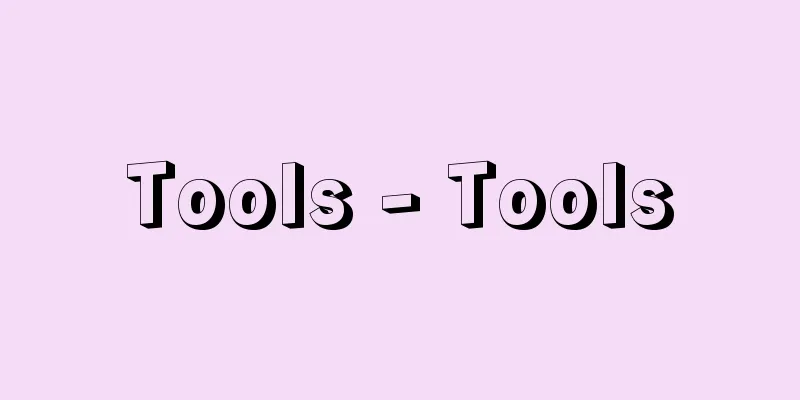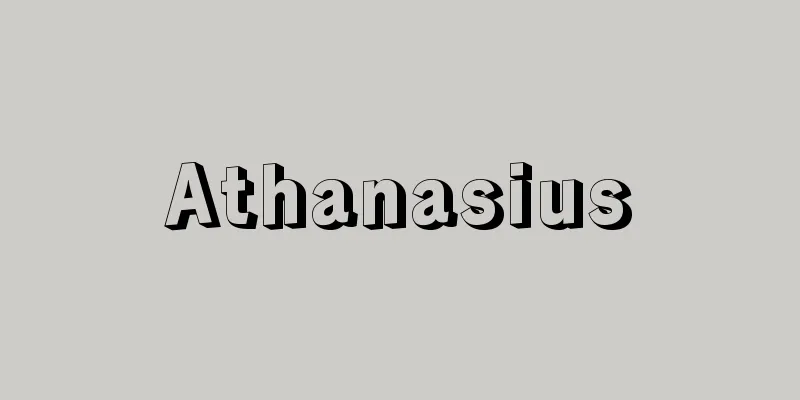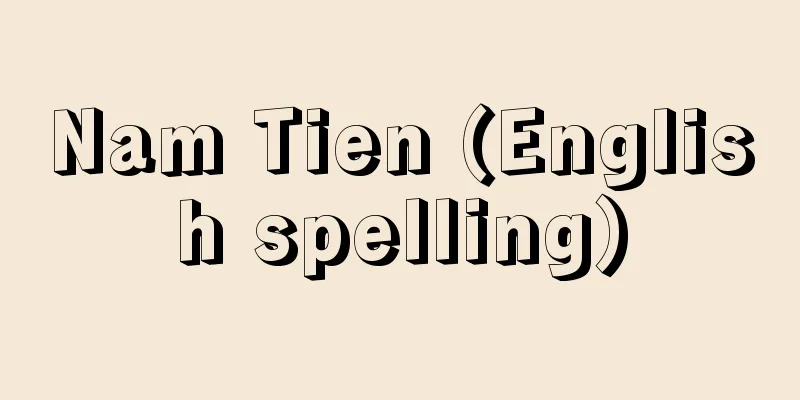Tools - Tools

|
Not only tools, but machines and appliances around us can be said to replace the functions of human organs with the outside world and further expand or extend those functions. For example, a camera externalizes the functions of the eyes and allows the recording of the images to be saved, and a computer replaces the functions of the brain with a machine. The German technological philosopher Ernst Kapp (1808-1896) expressed this as organ projection, which he said is the replacement of an internal mechanism with the outside world. Philosopher Ludwig Noiré (1829-1889) also stated that tools are a means to accomplish a certain function and correspond to the principle of creation. In other words, whether tools or machines, they are intended to assist the functions of human organs in creating things. [Ken Uchida] What is a tool?It is difficult to distinguish between tools and machines, but from ancient times to the present, attempts have been made to distinguish between the two. For example, Vitruvius, a Roman architect from around the 1st century BC, wrote in his Ten Books on Architecture, "...there are some that function as mecanē (machines) and some that function as organons (tools). The following difference seems to exist between machines and tools: machines are constructed so that they are effective when many people and a great deal of force are required...tools accomplish their intended purpose by carefully operating them with one hand." In other words, machines are those that exert their power by concentrating many people's efforts, while tools produce great effects by requiring individual skill. Machines, which required the concentration of many people's efforts, were replaced by mechanical and electrical power during the Industrial Revolution. The 19th century German engineer Rouleaux wrote in Mechanics that "a machine is a combination of objects with a resistance, by means of which mechanical forces are able to perform a task with a definite and decisive movement." However, American critic of civilization Mumford said that the distinction between a tool and a machine depends on the degree to which the operation is independent of the skill and power of the person operating it, that is, a tool depends on the flexibility of hand and dexterity, while a machine is due to the specialization of functions through automatic action. He also said that somewhere between the two there are machine tools, which combine the accuracy of an elaborate machine with the assistance of a skilled craftsman. In other words, a machine places emphasis on the specialization of functions, while a tool expresses versatility. Along with the word "tool," the word "instrument" is often used. In everyday life, the terms "tool" and "instrument" are used ambiguously, but Noiret distinguishes between tools, instruments, and weapons by saying, "Tools are active and correspond to the principle of creation, instruments are passive and help preserve life, and weapons are destructive above all." In other words, tools are things used for production, such as farm tools and carpentry tools, instruments are things used to maintain life, such as teacups, desks, chairs, and beds, and weapons are things used to kill animals and humans. [Ken Uchida] Sacred Objects and Living ObjectsThroughout human history, in order to survive, humans have had to adapt to the environment they found themselves in. They also had to acquire the technology to control it, which led to the creation of tools. Anthropologist Fraser places early human culture in the context of magic, with theoretical magic as pseudo-science and practical magic as pseudo-technology. Primitive people who were controlled by collective consciousness through magic probably used magical tools in their daily lives. In those days, tools were used as sacred tools. On the other hand, the production of tools began out of the necessity of secular life, and magical tools that existed as pseudo-technology were replaced by secular tools. In Japan, "dogu" is also a word used in Buddhism, and it is written in the Middle Agama Sutra that "things that are accumulated, that are things that can help one to advance on the path, are tools that increase the virtues of the law." In other words, dogu means tools that help human life and allow humans to live in accordance with the Buddhist path. Both are sacred tools, and the word "chodo" was used to refer to secular tools for daily life. [Ken Uchida] History of toolsThe evolution of human tool technology involves several stages in the production and use of tools. The first stage was the Dawn Age, when the ancestors of humankind, called Australopithecus, from the Pliocene epoch of the Tertiary Period, used readily available natural stones and crude stone tools as tools. The next stage was the Paleolithic Age, about 600,000 to 12,000 years ago, during the Ice Age, and marked the dawn of the Early Paleolithic Age, when the earliest species of the genus Homo, or Pithecanthropus, made tools accidentally. This was followed by the Early Paleolithic Age, when permanent tool making was observed. Around this time, many stone tools modified by human hands were found with the excavation of the Peking Man, and standardization began to be observed in the permanent tool making of the predecessors of Homo sapiens. For example, the hand axe, which was made by removing flakes from both sides of a pebble or slab of stone and had a sharp edge like a pointed tongue, was the first tool to show standardization. The basic techniques for processing stone tools, which became the source of various cultures that have developed in various ways, spread from Africa to Asia and Europe, with the development of stone-core hand axes in Africa, the stone-core culture seen in standard choppers in East Asia, and the flake culture in Western Asia and Europe. From the Middle Paleolithic to the Mesolithic periods, tools with complex shapes were made from animal bones, horns, ivory, etc., incorporating techniques for cutting, splitting, scraping, and polishing, and many tools were made as tools for making other tools. The Neolithic and Metal Ages are characterized by the creation by Homo sapiens of numerous tools (machines) that utilize mechanical principles. For tools to be used effectively, the surface where the hand and the tool come into contact, and the surface that processes the object, must be appropriate, as Friedrich Herig, a tool researcher in the early 20th century, said. However, already in this period, handles were attached to tools, and a method of giving the working edge or tip an appropriate motion to drill holes or carve the object being processed was adopted. It was during this period that javelin throwers, which utilized the principle of leverage, were created. [Ken Uchida] Hands and tools as tool organsNoiret divided the developmental stages of the human hand into three: (1) the hand as an organ of movement, (2) the hand as an organ of prehension, and (3) the hand as a tool organ. He stated that the hand qualified as a tool organ because of its function of "grasping." When the palm is spread open with all the fingers extended and the little finger side is used to hit an object, the hand becomes a chopper, and when in this state the hand spreads or stretches an object using the palm side, the hand acts as a spatula. When only one index finger is extended and the fingertip is used to twist the surface of an object, that finger acts as an awl. Also, when a depression is made in the palm and both hands are brought into contact with the little finger side, the hand can become a vessel. In this way, the hand can become various kinds of tools or containers by changing the state of the palm or the position of the fingers. A clenched fist can also function as a weapon. Tools, including weapons as removable appendages, first appeared when our human ancestors began to walk upright on two legs and were able to use their hands freely, to supplement the functions of their hands and teeth. In other words, because humans did not have the sharp teeth or strong hands of other animals, and were not blessed with the running ability, they used their hands to turn stones into projectiles and wooden sticks or long bones of animals as clubs. They also used natural stones with sharp edges to skin prey and cut meat, supplementing the functions of their hands and teeth, and eventually moved on to making permanent tools. [Ken Uchida] Hand and tool adaptationTools that depend on skill and dexterity to perform their functions must first be integrated with the hand, meaning that the tool must be made to fit the hand. As symbolized by the ancient rock paintings of tools and hands as one, tools must be designed to fit the size and strength of a person to use them easily. A typical example is the relationship between the hand and the handle. Handles were already attached to tools in ancient times, and were made to fit the hand through experience. For example, carpentry tools are tools that have a long history in the world of Japanese craftsmanship, and it has been said that the better a carpenter is at making tools, the better his skills are. The cutting edge of a tool, such as a chisel or plane, which is used to process objects, is sharpened by the carpenter himself to a cutting edge angle suited to each type of processing, and the handle of a saw or hammer, which is the point of contact between the tool and the hand, is made to fit the grip of the carpenter's own hand. Carpenters also dislike lending their tools to others. Tools created under such harsh conditions are also highly effective in terms of their functionality. However, in today's world, where not only machines but also tools and products are mass-produced, it is difficult to ensure that tools are used in a way that suits the physical dimensions and power of each individual. The adaptation of hands and tools was born against this background. This is the issue of man-machine interface in the world of ergonomics. This is the question of whether or not the push buttons, switches, rotary knobs, handles and other operating tools attached to machines are well adapted to the dimensions, shape and power of human hands and feet. If they are not adapted, not only will they be difficult to use, but they may also lead to incorrect operation and cause accidents. This is why we need operating tools that are suited to the various characteristics of humans. In other words, in the age of mass production, tools are designed to be easy for anyone to use by collecting a lot of information about human characteristics, and then using that information as a basis, the tools and products are designed and produced to suit the people who will use them. [Ken Uchida] Type of toolsNumerous tools have been created throughout the history of mankind, but the original forms of tools were almost complete in ancient Greece. To show the scope of the word "tool," the 19th century sociologist Espinas listed the tools used by Greek craftsmen, including levers, wedges, axes, hammers, saws, locks, metal tenons, perforated armrests, oars and sails, rudders, awls, spinning and weaving tools, ploughs, hole-making tools, and potter's wheels. The French scientist Proudhon also stated that "the most elementary and most common tools which man uses to do work, that is to say, the lever and the rod," and attempted to classify tools into the same number as the alphabet. According to this, tools were classified according to function as follows: A - Rod or lever (stick, stake, post, etc.). B - Hooks, curved rods (fishhooks, hooks, keys, anchors, shovels, harpoons, etc.). C - Clamping tools (pawns, vices, double hook combinations, etc.). D - Binding tools (lines, ropes, chains, soft stalks). E - Beating tools (sledgehammers, clubs, mallets, mortars, etc.). F - Sharp tools (spears, javelins, arrows, nails, etc.). G - Coins. H - Axes (knives, swords, swords). I - Files. J - Saws. K - Scooping tools (hoes, shovels, spoons, trowels). L - Hoes (combs, rakes, etc.). M and N - Inclines. O—Roller (what gives rotation to a wheel or pulley). P—Pipe (pipe, siphon, drain, chimney). Q—Oar and rudder. R—Bow (spring). S—Rule. T—Level. U—Straightedge. V—Compass. X—Plumb bob or pendulum. Y—Scales. Z—Circle (ball and knot). Among these tools are included five simple machines which make up all modern machinery: the lever, the pulley, the wheel and axle, the inclined plane and wedge, and the screw. These simple machines were anciently linked to a single natural principle, the "law of the lever." [Ken Uchida] "Tools and Their Significance for the History of Human Development" by L. Noiret, translated by Saegusa Hiroto (Iwanami Bunko) " ▽ "Machines" by Yoshida Mitsukuni (1974, Hosei University Press) ▽ "The History of Technology" (Saegusa Hiroto Collected Works 10, 1973, Chuokoron-Shinsha)" ▽ "The History of Technology 1" edited by C. Singer et al., translated and edited by Hirata Hiroshi and Yasugi Ryuichi (1978, Chikuma Shobo) [Reference] | |Source: Shogakukan Encyclopedia Nipponica About Encyclopedia Nipponica Information | Legend |
|
道具に限らず、われわれの身の周りにある機械や器具は、人間の器官の働きを外の世界に置き換え、さらにその働きを拡大したり延長したものといえる。たとえばカメラは目の働きを外化し、その映像の記録を保存できるようにしたものであり、コンピュータは大脳の働きを機械に置き換えたものである。ドイツの技術哲学者カップErnst Kapp(1808―1896)は、これを器官射影ということばで表現し、器官射影とは内なる機構の外の世界への置換である、としている。また哲学者ノワレLudwig Noiré(1829―1889)は、道具はある働きを遂行するための手段であり、創造してゆく原理に相応している、と述べている。いいかえれば、道具にしても機械にしても、物をつくりだすために人間の器官の働きを助けるためのものである。 [内田 謙] 道具とは道具と機械を区別して定義することはむずかしいが、古代から今日に至るまで、この二つを区別して定義づけることが試みられてきた。たとえば紀元前1世紀ころのローマの建築家ウィトルウィウスは、『建築十書』で「……これらのうちにメーカネー(器械)として作動するものとオルガノン(道具)として作動するものとがある。器械と道具の間には次の差異があると思われる。器械は多くの人手と大きな力で効果を発揮するように組み立てられている、……道具は一人の手で慎重に操作することによって企図されている目的を成就(じょうじゅ)する」と述べている。つまり器械とは多くの人力を集中して力が発揮されるものであり、道具は個人の技能が要求されて大きな効果を生み出すとする。多くの人力の集中を必要とした器械は、産業革命を経て機械力、電気力に置き換えられた。19世紀のドイツの工学者ルーローは「機械とはその手段によって機械的な自然力が一定の決定的運動を伴って作業を遂行できるようにつくられた一つの抵抗力を備えた物体の組合せである」と『機械学』のなかで述べているが、アメリカの文明批評家マンフォードは、道具と機械の区別は、それを操作する人の熟練や動力からその操作がどれだけ独立しているかの程度に依存する、つまり道具は手加減と器用さの融通性に依存し、機械は自動作用による機能の専門化によるものである、という。そして、これらの中間に工作機械があり、工作機械は精巧な機械の正確さと熟練した職人の介添えをあわせもっていると述べている。換言すれば、機械とは機能の専門化に重点を置き、道具は融通性を表現したものである。 道具ということばとともに、しばしば器具ということばが用いられる。日常においても道具と器具はあいまいのまま使われているが、ノワレは、道具、器具、武器の区別について、「道具は能動的であり創造してゆく原理に相応し、器具は受動的で生命の保持に役だつものであり、武器はなによりも破壊的である」としている。つまり、道具は農具や大工道具などのように生産のために用いられるもの、器具は茶碗(ちゃわん)や机・椅子(いす)、ベッドなどのように生命を維持してゆくときに使われるものであり、武器は動物や人間を殺傷するために使われるものである。 [内田 謙] 聖なる具と生活の具人類の歴史において、人は生き続けるためにまず置かれた環境に適応しなければならなかった。さらにそれを支配するための技術を身につけなければならなかったし、そこから道具もつくられた。 人類学者のフレーザーは、人類の初期文化を呪術(じゅじゅつ)のなかに位置づけ、理論的呪術を擬科学としての呪術、実際的呪術を擬技術としての呪術であるとしているが、おそらく呪術を通して集合意識に支配されていた原始人は、その生活のなかで呪具を用いていたであろう。そこでは道具は聖なる具として用いられたのである。一方、俗なる生活の必要から道具の製作が始まり、擬技術として存在した呪具は、俗な道具に置き換えられる。 日本においても、「道具」は仏教のなかで用いられたことばであって、「蓄うる所の物、身を資(たす)け道を進むべき者、即(すなわ)ち是(こ)れ善法を増長するの具」(中阿含(あごん)経)と記されている。つまり道具とは人間の生を助け、人間が仏道に従って生きるための具をいう。いずれも聖なる具であって、これに対して俗なる生活用具には調度ということばが使われた。 [内田 謙] 道具の歴史人類の道具技術の進化のなかで、道具の製作とその使用にはいくつかの段階がみられる。 第一の段階は、第三紀鮮新世のアウストラロピテクスとよばれる人類の祖先が、ありあわせの天然石や粗製の石器を道具として使った「曙石器」の時代である。次の段階は、氷河期にあたるほぼ60万~1万2000年前の旧石器時代で、まず偶発的な道具の製作をしたピテカントロプス類またはヒト属の最古の種の前期旧石器時代の夜明けである。続いて、恒常的な道具の製作がみられる前期旧石器時代である。このころになると、北京(ペキン)原人の発掘とともに、人の手が加えられた多くの石器がみつかっており、ホモ・サピエンスの先行者による恒常的な道具の製作のなかに標準化がみられるようになる。たとえば、礫(れき)または板状の石の両側から剥片(はくへん)をはぎとり、鋭い縁をもったとがった舌のような形をした握斧(あくふ)は標準化がみられる最初の道具である。 さまざまな発展をみせる文化の源泉となった基本的な石器加工の技術は、アフリカからアジアおよびヨーロッパに広がり、アフリカでは石核の握斧が、東アジアでは標準型のチョッパーにみられる石核文化が、そして西アジアとヨーロッパでは剥片文化がそれぞれ発達している。中期旧石器時代から中石器時代には複雑な形をした道具が、引き切る、裂く、削る、磨くなどの技術を取り入れて、動物の骨や角(つの)、象牙(ぞうげ)などでつくられており、また多くの道具が道具をつくるための道具としてつくられた。 力学的原理を利用した道具(機械)がホモ・サピエンスによって数多くつくられたのが、新石器時代および金属器時代の特徴である。道具の有効な利用のためには、20世紀初頭の道具の研究家ヘーリヒFriedrich Herigのいう、手と道具の接する面Handseiteと物を加工する面Arbeitsseiteが適切でないと十分な効果を発揮することはできないが、すでにこの時代に道具に柄(え)がつけられ、その作用する縁や先端に適切な運動を与えて、加工する対象物に孔をあけたり、削ったりする方法が取り入れられている。てこの原理を利用した槍(やり)投げ器がつくられたのもこの時代である。 [内田 謙] 道具器官としての手と道具ノワレは、人間の手の発展段階を三つに分けて、(1)運動器官としての手、(2)捕捉器官(ほそくきかん)としての手、および(3)道具器官としての手をあげ、手が道具器官としてその資格をかちえたのは「つかむ」ことの働きによると述べている。 掌(手のひら)を広げてすべての指をそろえて伸ばした状態にし、小指側で物をたたくとき、手はチョッパーとなり、またその状態で掌側で物を広げたり伸ばしたりするとき、手は篦(へら)の役割をする。示指を1本だけ伸ばして、指先で物の表面にひねる運動をするとき、その指は錐(きり)の働きをする。また掌にくぼみをつくって両手を小指側で接触させると手は器(うつわ)にもなる。このように手は掌の状態を変えたり、指の位置を変化させることによってさまざまの種類の道具や容器になる。また握りこぶしは武器の役割もする。 取り外しのできる付加物としての武器を含めた道具は、人類の祖先が直立二足歩行を始め、手が自由に使えるようになって初めて登場し、手と歯の機能を補った。つまり人類は、ほかの動物のように鋭い歯も力強い手ももたず、走力にも恵まれなかったために、手を使って石を飛び道具とし、木の棒や動物の長骨を棍棒(こんぼう)として用いた。また獲物の皮をはいだり、肉を断ち切るために、鋭い縁のある天然の石を用いて、手や歯の働きを補い、やがて恒常的な道具の製作に移行していく。 [内田 謙] 手と道具の適応手加減と器用さにゆだねられてその効力を発揮する道具は、まず手と道具の一体化、つまり道具は手になじむようにつくられる必要がある。古代の岩壁画に描かれている道具と手が一つになっている絵が象徴しているように、道具は人間が使いやすい寸法や筋力などに見合ったものでなければならない。その代表的なものが手と把手(とって)との関係である。把手は、すでに古代の道具につけられ、体験的に手になじむようにつくられてきた。たとえば、日本の物づくりの世界で長い歴史をもつ道具に大工道具があり、道具づくりの上手な大工ほど腕がよいといわれてきた。物を加工する面すなわち、のみや鉋(かんな)などの刃先は、それぞれの加工に見合った刃先角に大工自らの手で研ぎ込まれ、道具と手の接点である鋸(のこぎり)や金槌(かなづち)などの柄は、大工自身の手の握りに適合する形につくられる。大工は自分の道具を他人に貸すことも嫌う。このように厳しい条件のなかで生み出される道具は、道具機能の面からみても優れた効果を発揮する。 しかし今日のように、機械に限らず道具や製品が大量生産される時代では、道具が個人個人の身体寸法や出力に見合った形で使われるようにすることはむずかしい。手と道具の適応はそうした背景のなかで生まれている。いわゆる人間工学の世界でいうマン・マシン・インターフェースの問題である。これは、機械類に取り付けられている押しボタンやスイッチ、回転ノブ、ハンドルなどの操作具と、人間の手や足の寸法や形態、その出力などがうまく適応しているか否かの問題で、もし適応していない場合には使いにくくなるばかりでなく、誤操作を生じ事故の原因ともなりかねない。そこで人間のさまざまの特性に見合った操作具が必要となってくる。 つまり、大量生産時代の道具類は、だれが使っても使いやすいように、人間の諸特性に関する多くの資料を集めて、その資料を基にして、その道具や製品を使う対象に見合うように、道具や製品を設計し、生産していくのである。 [内田 謙] 道具の種類道具は人類の歴史とともに数多くのものがつくられてきたが、その原形は古代ギリシア時代にほぼ出そろっている。19世紀の社会学者エスピナスは、道具ということばが用いられる範囲を示すために、ギリシアの工人たちが使った道具をあげているが、それらは、てこ、くさび、斧(おの)、槌、鋸、錠前、金属の枘(ほぞ)、孔(あな)のあいた肱金(ひじがね)、橈(かい)と帆、舵(かじ)、錐、錘(つ)む・織る道具、犂(すき)、孔をあける道具、ろくろなどである。 またフランスのプルードンは「人間が仕事をするために使うもっとも基本的な、もっとも一般的な道具、つまりそれらの道具の帰するところは、てこと棒である」と述べ、道具をアルファベットと同じ数に分類することを試みているが、それによると機能別の道具の分類は次のようなものである。 A―棒あるいはてこ(棒、杭(くい)、支柱など)。B―鉤(かぎ)類、曲がった棒(釣り針、懸け金(かけがね)、鍵(かぎ)、錨(いかり)、枘、銛(もり)など)。C―挟む道具(やっとこ、万力、二つの鉤の組合せなど)。D―縛るもの(糸、綱、鎖、柔らかい木の茎)。E―たたく道具(大槌、棍棒、槌、石臼(いしうす)など)。F―先のとがった道具(槍、投槍、矢、釘(くぎ)など)。G―コイン。H―斧(包丁、刀、剣)。I―鑢(やすり)。J―鋸。K―すくう道具(鋤(すき)、スコップ、スプーン、鏝(こて))。L―股鍬(またぐわ)(櫛(くし)、熊手(くまで)など)。M・N―傾斜。O―ころ(車輪や滑車に回転を与えるもの)。P―管(管、サイホン、排水溝、煙突)。Q―橈と舵。R―弓(ばね)。S―物差し。T―水準器。U―直角定規。V―コンパス。X―下げ振りあるいは振り子。Y―秤(はかり)。Z―円(球および結び目)。 以上のように道具としてあげられているなかには、今日のあらゆる機械を構成する五つの単一機械、つまりてこ、滑車、車輪と車軸、斜面とくさび、ねじが含まれている。これらの単一機械は古代においては一つの自然原理である「てこの法則」に結び付けられていたものである。 [内田 謙] 『L・ノワレ著、三枝博音訳『道具と人類の発展史に対するその意義』(岩波文庫)』▽『吉田光邦著『機械』(1974・法政大学出版局)』▽『『技術の歴史』(『三枝博音著作集10』1973・中央公論社)』▽『C・シンガー他編、平田寛・八杉龍一訳・編『技術の歴史1』(1978・筑摩書房)』 [参照項目] | |出典 小学館 日本大百科全書(ニッポニカ)日本大百科全書(ニッポニカ)について 情報 | 凡例 |
<<: Crown Prince/Spring Prince - Togu
Recommend
Red-streaked Pheasant (bird) - Red-streaked Pheasant
...The Shikoku Copper Pheasant P. s . intermedius...
Pseudocilia - Pseudocilia
…The cells are spherical, 5 to 10 μm in diameter,...
Pei Shiqing - Pei Shiqing
Date of birth and death unknown. An official of t...
Critical concentration - GENKAINOUDO
A measure of the sensitivity of a detection react...
Aikawa [town] - Aikawa
A town in Aiko District, in the northern part of K...
Hamazakura (English name) Sonneratia alba Sm.
An evergreen tall tree of the family Saltaceae, it...
Osaka Bill Clearing House
...The organization formed by financial instituti...
Azlon (English spelling)
A general term for regenerated protein fibers made...
Osaka City University
It is a public university corporation. It origina...
Saiki Bay
A bay on the ria coast in the southwest of Oita P...
al-Mustanṣir (English spelling) alMustansir
…Meanwhile, the Ismaili missionary organization w...
Ethno-sciences
... From this new perspective, the diachronic vie...
Perilla genus - Perilla genus
...The fruit is elongated and opens to a length o...
Bastard wing
...There are 6 (hummingbirds) to 32 (albatrosses)...
phasin (English spelling)
…The two ends of a piece of cloth measuring 2–4 m...









